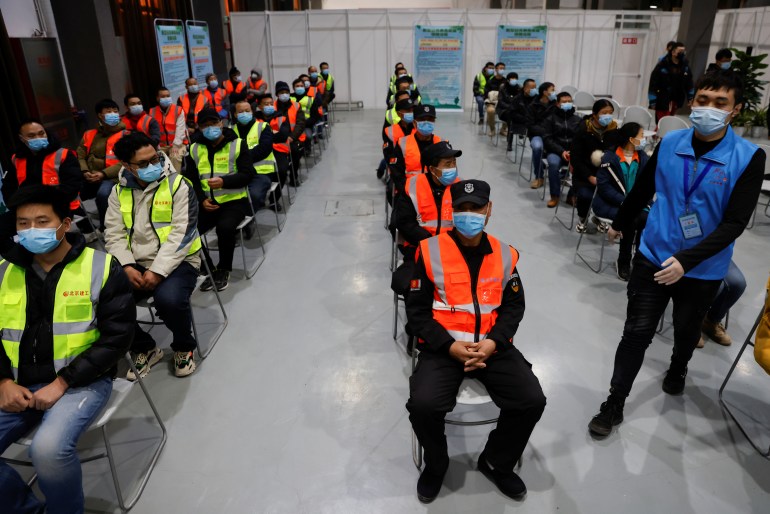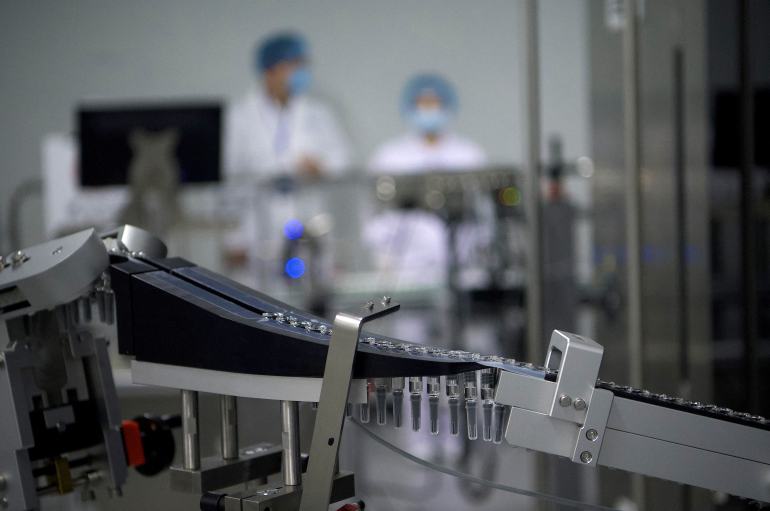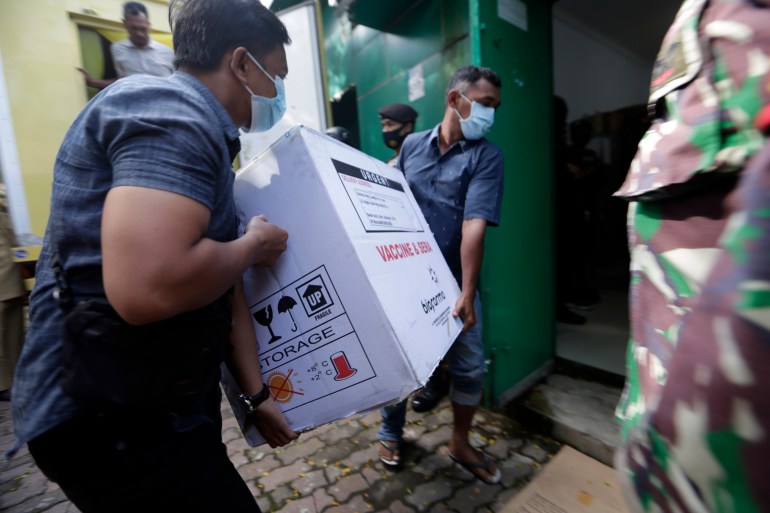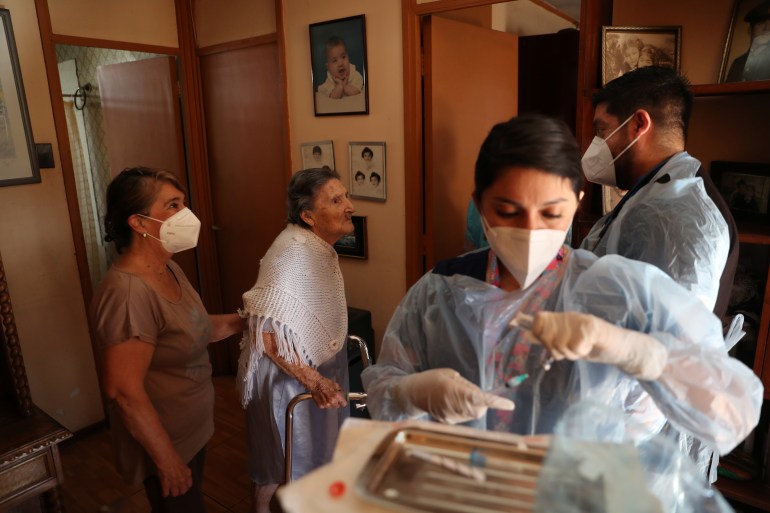China risks COVID ‘immunity gap’ amid slow vaccine uptake
A year after a pandemic was declared, China has so few cases of the disease that people see little need to get vaccinated.

Shenzhen, China – It is 10am (02:00 GMT) on a Tuesday morning at the only designated COVID-19 vaccination clinic servicing the 650,000 officially registered residents of Shenzhen’s Bao’an district – and there is hardly anyone in sight.
There are no lines stretching outside the door.
Keep reading
list of 4 itemsCOVID: UK variant up to 100 percent more deadly, study finds
Questions surround Turkey’s COVID strategy as cases surge
‘No winning’: US working mothers on losing ground to COVID
A single nurse at the check-in desk, a security guard, a volunteer directing patients and a couple of other nurses behind a partition far outnumber the one man there for his vaccination.
Only about 4 percent of China’s population was vaccinated against the coronavirus by the end of February but there appears to be little sense of urgency among most health officials or the public about it.
The reported goal is to vaccinate 40 percent of the population by the end of July – which would mean vaccinating 560 million more people – and achieve possible herd immunity by the end of the year in time for the 2022 Beijing Winter Olympics.

Reaching those targets will require an enormous government push but there are few signs of that happening. And the country’s success in controlling the virus has ironically reduced the incentive to get protected, resulting in an “immunity gap” that leaves China’s population at risk and necessitates continued strict border controls and localised lockdowns when outbreaks occur.
Such checks have helped contain the spread of the virus in China since it first emerged in the central city of Wuhan at the end of 2019 – but it has also left in a large part of the population vulnerable to contracting COVID-19.
“Most people in China remain susceptible to COVID-19, and elsewhere people already have antibodies and immunity, so then China will be in a very, very dangerous situation because if the virus is reintroduced, something like what happened in Wuhan might happen again,” Jin Dongyan, a professor at the School of Biomedical Sciences at the University of Hong Kong, told Al Jazeera.
“I’m not sure they can achieve [those vaccination rates] because I don’t think they have a clear plan to vaccinate all of the Chinese people,” he said.
Zhang Wenhong, the head of the Shanghai Huashan Hospital recently told an online discussion with top global health experts organised by the Washington-based Brookings Institution that the pace of vaccination was a “great concern”.
Zhang said that production of vaccines in China was likely to reach approximately two billion by the end of the year which would be enough to reach herd immunity in about 70 percent of the 1.4 billion population, but he did not disclose any details on how the government planned to get more people inoculated.
‘Safe and stable’
Visits to several clinics in Shezhen revealed that the pace of vaccination schemes was slow and supplies were lacking. At the Bao’an clinic, nurses said vaccine stocks were low in Shenzhen, resulting in them prioritising healthcare workers in addition to employees in international shipping, aviation, food services and public transport.
Visits to two other clinics in the nearby Nanshan district in Shenzhen showed similar findings – and relatively few patients waiting to get the jab. Staff at one clinic said they had only received the second shot of a two-part vaccine. And the other clinic while offering foreigners vaccines, would only dispense them to those with plans to travel abroad.

Besides the slow pace of the vaccines’ release, a widespread distrust due to past substandard or expired jabs still persists. Annual inoculation rates for influenza in China hover only at about 2 percent.
However, initial scepticism about the safety and efficacy of the four domestically produced vaccines appears to have dissipated somewhat. The first phase involved more than 52 million people, starting with front-line workers and in areas affected before the Lunar New Year holiday earlier this year.
“I’ve gone to my community hospital but need to get on a waiting list, and they only had the second shot available so I couldn’t take that anyway,” Mr Lin, an insurance agent who did not want his full name used, told Al Jazeera.
“Since it is so safe and stable in China, I think we can put it off until a bit later. As far as safety, I don’t think there’s a problem and trust the authorities to arrange a safe vaccine.”
The country’s primary development document released at the start of annual National People’s Congress meetings in Beijing on March 5 placed the prevention of imported virus cases at the top of its priorities list, suggesting those border controls were likely stay in place into the next year.

Lu Zhicong, an assistant professor at City University of Hong Kong who studies Chinese social media discourse said that widely publicised stories on the virus’ successful containment combined with the government’s track record of containing COVID-19 have lessened the urgency for getting inoculated immediately.
“The [virus] situation in the mainland is so good, and places like my hometown in Ningxia [in Western China] there haven’t been cases since long, long ago, so no one would really bother [getting vaccinated],” he said. “In a lot of cities there’s very little chance to get infected, so they probably won’t get the shot. For international students going abroad, maybe, but other people don’t think it’s necessary.”
Vaccine diplomacy
As many other countries around the world race to vaccinate their populations in an attempt to reach a level of herd immunity that would allow much more normal travel, business and daily life, China’s government has instead focused on exporting vaccines to other countries.
Chinese manufacturers have conducted large-scale trials in countries including Brazil and Indonesia and dispatched supplies to nations across the world including parts of Asia, Africa, South America and Eastern Europe.
“From my discussion with friends in China who serve in the government or top universities, they told me that the strategy is that China would like to have what they call vaccine diplomacy, especially in the first half of the year,” Chen Xi, an associate professor of health policy and economics at the Yale School of Public Health told Al Jazeera.
“So the strategy is to first supply the rest of the world before they come back to vaccinate more and more people in China,” Chen said.


On Thursday, Ministry of Foreign Affairs spokesperson Zhao Lijian said that Chinese companies involved in vaccine production had applied for certification from the World Health Organization and the process was under way.
China has had a total of 100,758 cases and 4,833 deaths, according to data from Johns Hopkins University, nearly all of them in Wuhan which spread the virus a year ago when the World Health Organization first declared it a pandemic.
The National Health Commission confirmed 11 new cases on Wednesday, all of them among people returning to China from overseas.
“The immunity gap is a concern shared by many people, including myself,” Chen said. “I think China may have enough time to catch up, if we’re talking about [higher vaccination rates by] the end of this year, but if you think about getting that by summer, I have a concern whether this can be true.”